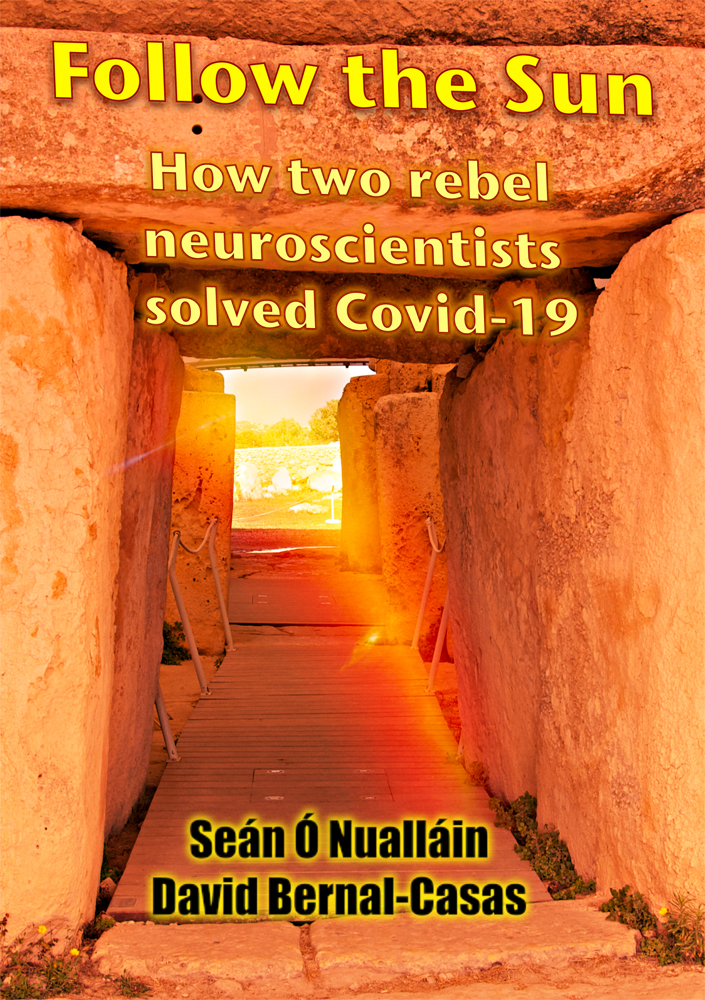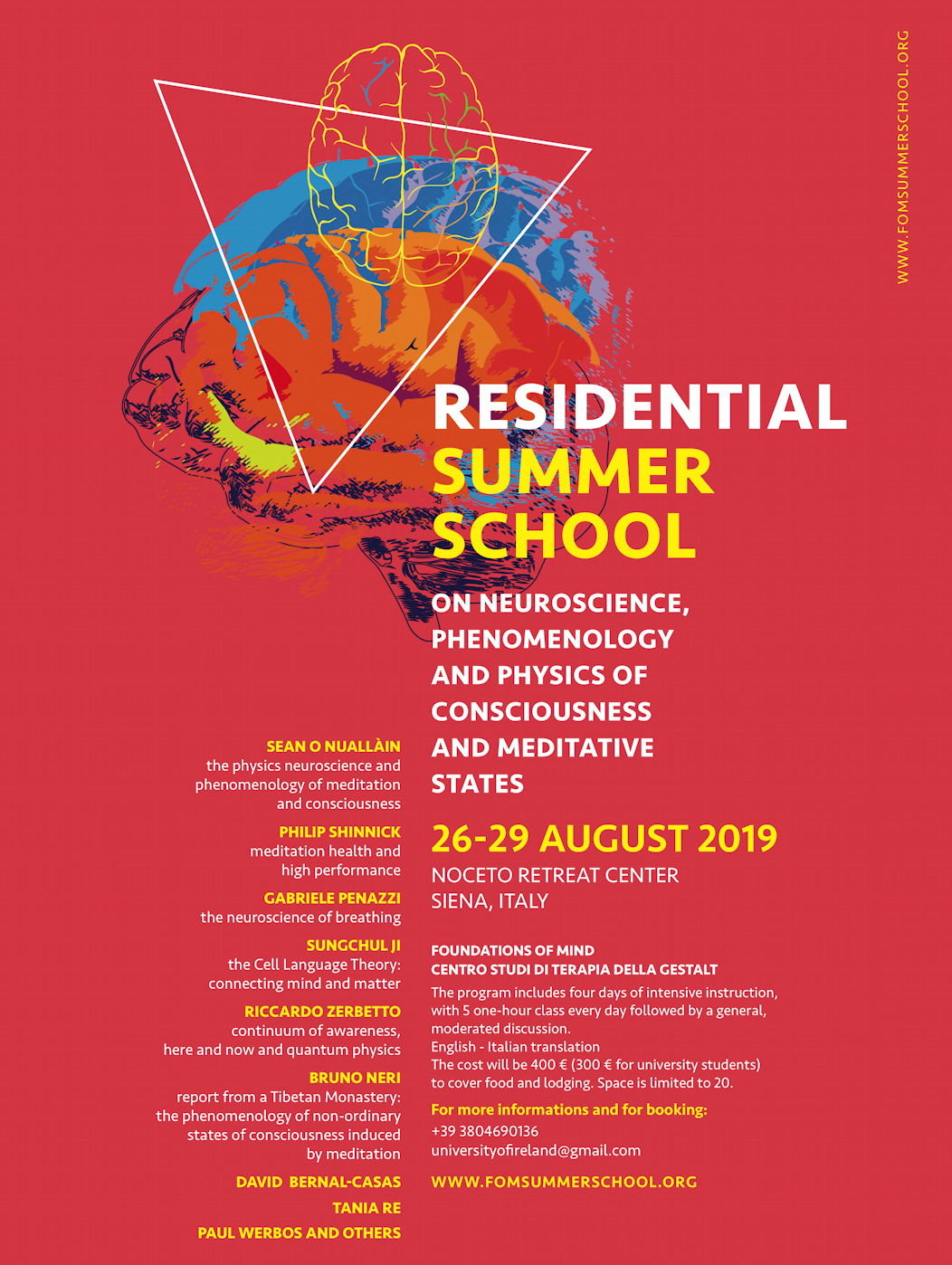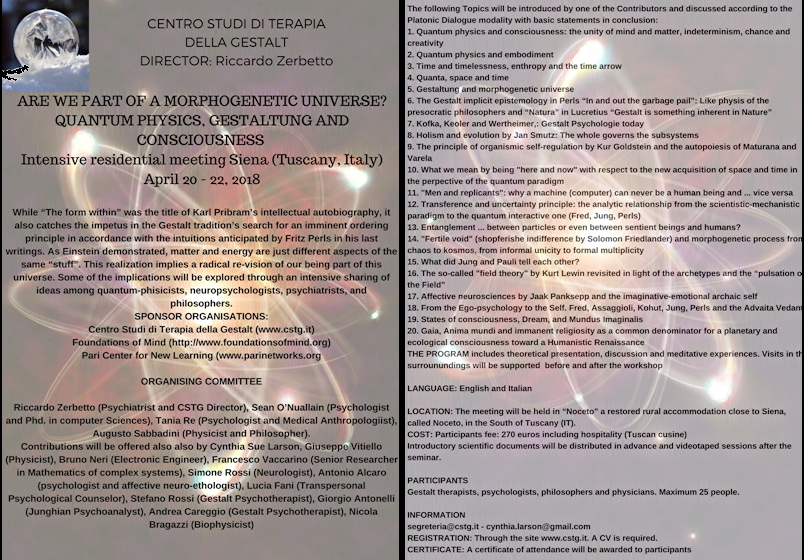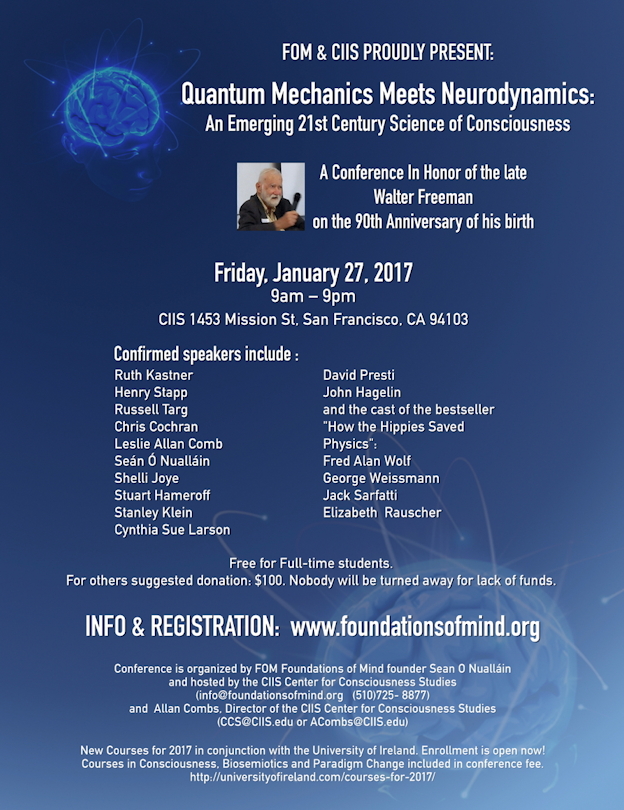| |
|
Online Summer School 29/08 - 06/09 2020:
Consciousness and Cognition
University of Pisa
and Foundations of Mind
Accredited for 4 ECTS credits • valid worldwide • Click For Details
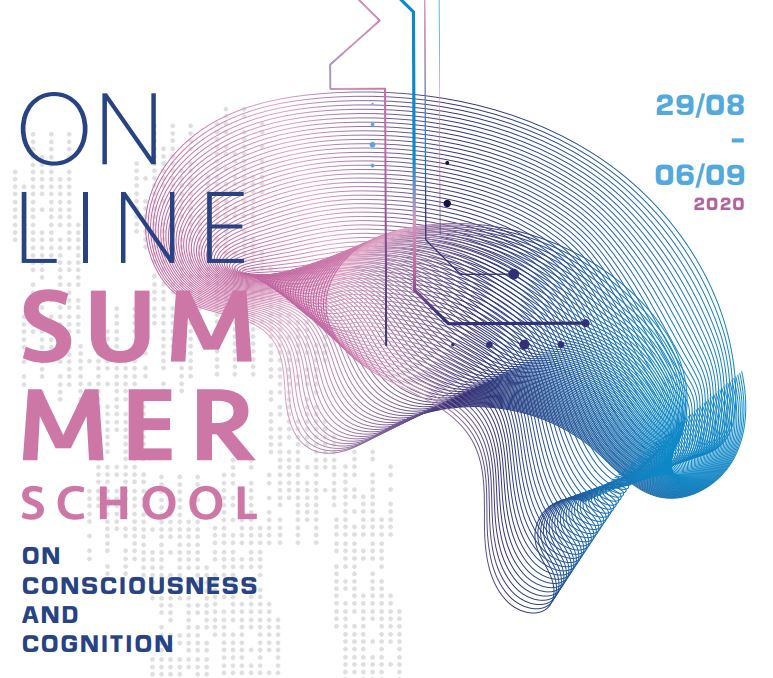
|
|
Premium Content
View video from the Foundations of Mind conferences, including a world-premiere exclusive as Russ Targ reveals the CIA’s positive
report on their remote viewing experiments, the editor’s selection of the 123 papers thematically organized, and courseware in neurodynamics.
Your donation also gets you an invitation to the Foundations of Mind and Bionoetics discussion groups. These groups work from the premise that the pressing problems of mind and life need an approach including but not limited to current academia. Our posters include people from all continents and walks of life, from a rancher in Montana with one of the highest IQs ever recorded to a Nobel laureate in physics! The inventors of Deep Learning and the Josephson Junction are both regular posters. The age range is from a Princeton freshman to Henry Stapp, a nonagenarian who worked with John Wheeler, Werner Heisenberg, and Wolfgang Pauli. We work in complete and radical intellectual freedom!
The cost for access to all of this content is $100. Sign up and immediate access!
Important: After you pay, click RETURN TO MERCHANT to see the premium content.
|
|
Foundations of Mind V:
The New AI Scare
Nov. 3–4, 2017 • Room 304, CIIS
1453 Mission St, San Francisco, CA 94103
Conference Schedule
In terms of downloads (150,000 per year), annual page views (27 million+) ,and peer-reviewed papers (more than 100 in its first 3 years, from March
2014 to March 2017), Foundations of Mind is now the world’s leading science of mind research group. While centered on cognitive science, it has featured many papers on the quantum mechanics view of mind, the foundations of physics and biology, and indeed ecology and health as manifestations of mind.
Its most recent proceedings volume, published in March 2017, received a total of 4,333 downloads in its first month, with the top papers receiving 750+, about what ACM papers typically take 25 years to achieve.
Please note we are secular, and totally independent; we have never taken corporate or state money, nor have we gamed the system as others do by asking our students to link to or download our work.
Nov 3: The New AI Scare
AI systems will keep us as pets. Massive unemployment as computers learn to drive cars, translate accurately, stock shelves, and much else. Silicon-based life forms reflecting on the brief carbon-based
intelligence era before the singularity.
All of these themes are rampant in the second decade of the 21st century. Yet they do not reveal the full story. The “pets” idea, repeated ad nauseam by Elon Musk, is an echo of Marvin Minsky a generation ago. It is a safe bet that no, you will not be ordering a driverless taxi to take you to a random destination you specify anytime before 2022. The much-vaunted successes of Deep Thought are due to a venerable algorithm called stochastic gradient descent, which now converges to a solution because computers are about 100 million times faster than they were during the last AI scare of the 1980s and almost infinitely faster than during Minsky’s abortive 1950s scare.
This session invited papers on what computers, even now, can’t do, and above all why that is the case. It encourages participants to speculate on aspects of the architecture of the cortex that allows a 20-watt “computer” (that would be the thing under your skull) to outperform machines with terahertz speed and petabyte memory. It invited papers on quantum computation as a natural outcome of human cognition and noesis. It also welcomes those who in turn wish to usher in the new post-singularity era. After all, the phrase and concept originally derive from Johnny von Neumann, the founder of many aspects of computing as well as quantum mechanics.
Above all, we invited recapitulation of the themes broached in Penrose’s masterpiece about the relationship between consciousness and computability. His viewpoint fused elements from the theory of computability (partially recursive functions), non-determinism, tiling theory, and phenomenology. The relationship with formal language theory was not explored, nor was an explicit engagement with the fact that all observer-dependent measurement in QM involves the infinite. The re-assertion of human noesis may pave the way for that of human dignity.
Specifically, we invited papers on the following themes:
- Machine Translation (MT): Computers have been getting MT almost right since the 1950s. attendees are asked to consider two dilemmas: that checking a translation is at least as time-consuming as producing one, and that 99.9% correct is not good enough even for an academic textbook.
- Kill Chain: use of AI systems in the “kill chain” in combat is burgeoning. Yet it is being done in the face of objections from experts like military strategists Rivollo and van Riper, who insist on precise targeting and reading of the enemy’s psychology.
- Neglected Research: The apparent magic wrought by the likes of Sutskever at Google has meant that linguistics research into issues like speech-acts and conversational implicatures is being elided. The inappropriate use of the word “neural” as a modifier for convolutional nets has led to neuroscience reverting to its 1940s archetype, with invasive fiddling around under the hood again the method de jour.
- Language was famously promoted as the royal road to the infinite by
the symbolists. What is the relationship between their “semantic
transcendentalism” and the role of infinite quantities in quantum
mechanics? What does this mean for AI?
- Finally, we invited papers that explore the fact that ordering on a
smartphone has meant that both AirBnB and Uber were somehow exempt from
normal regulations for accommodation and transport. Could this AI
scare be a way of persuading us that resistance is futile in our
Taskrabbit dystopia? Papers also are welcome that explain that it is
in fact a Utopia. Or is it arguable that the successes of Google,
Facbook, et al. are largely based on truly cosmic levels of copyright
violation, and that states should administer many of their functions
under the rubric of public libraries (and indeed e-mail systems).
Papers were are invited on the classic foundations of mind themes: the
formal inadequacy of received accounts of mind and brain (leading to
$6 billion being spent by the NIH in 25 years on brain imaging without
a single therapy emerging); the foundations of biology; the observer
in physics; quantum mind.
|
And ... now available from Cambridge Scholars Publishing —
The first Foundations of Mind book:
Dualism, Platonism and Voluntarism
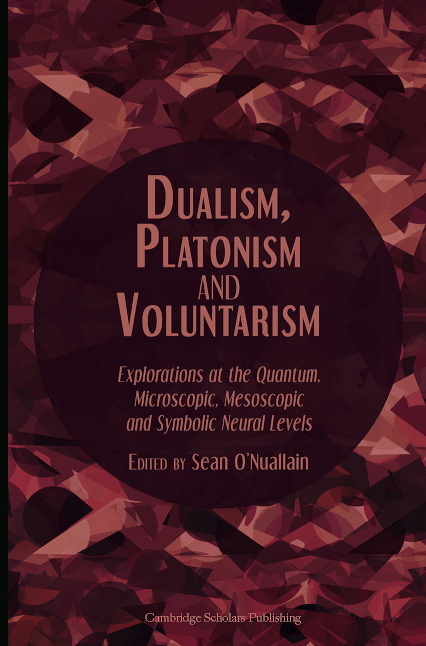
Introducing Foundations of Mind
Who we are and what we do
We are neuroscientists, physicists, philosophers, and psychologists
from ages 20 to 90. We include University of California juniors, Nobel laureates, and social activists. We are secular, with a membership including all ethnicities, the LGBTQ community — and we even have a Gaelic-speaking (lapsed) Irish Catholic.
We publish prolifically — at a rate substantially greater in peer-reviewed outlets than any cogitive-science department. Our next proceedings will be published October 2016. Moreover, we allow writers to hold their copyright without payment, nor do we charge for public access. We have published articles by Stu Kauffman, our mentors Walter Freeman and Henry Stapp, Jacob Needleman, and many others; the quality is second to none.
Our conferences and seminars have so far taken place at UC Berkeley.
Our view of consciousness
While a definition of consciousness may or may not be helpful, it is possible to identify signatures at the neural, informational, metabolic and phenomenal levels that distinguish conscious states from dreams on the one hand and from intermediate waking states on the other. At the neural level, conscious states are characterized by gamma-phase synchrony over an appreciable amount of time, from fractions of seconds upward. At the informational level, conscious states involve modulation of the gamma wave broadcast over the whole cortex, which constitutes the “content” presented to the subject. If that content is minimal, the conscious state may be called “meditation” and may last up to hours.
At the metabolic level, power consumption by the brain dips due to the superposition of the gamma on the white noise constituting random neural firing. At the phenomenal level, unlike dreams, conscious content is consistent. Moreover, this consistency does not apply to normal waking states, when narration to oneself may be fallacious.
More speculatively, it may be possible to identify signatures at the quantum level, and to identify biological substrates like microtubules that can sustain quantum coherent states at physiological temperatures. That task will comprise the life’s work of many of the 21st century’s finest minds.
|
Proceedings of Foundations of Mind VIII, The Physics of Mind and Consciousness are imminent!
Proceedings of Foundations of Mind VII (2018) are now available free on the e-journal Cosmos and History.
Proceedings of Foundations of Mind V (Nov. 2017) are now available free on the e-journal Cosmos and History.
Proceedings of Foundations of Mind IV (Jan. 2017) are now available free on the e-journal Cosmos and History.
Proceedings of Foundations of Mind III (2016) are now available free on the e-journal Cosmos and History.
Proceedings of Foundations of Mind II (2015) are now available free on the e-journal Cosmos and History.
Proceedings of Foundations of Mind I (2014) are now available free on the e-journal Cosmos and History.
Since we started publishing with Cosmos and History, its page views have gone from 900,000 per year to more than 28 million in 2015!
Our original Foundations of Mind papers are being downloaded at an increasing rate (now more than 100,000 downloads per year), with the top papers receiving more than 100 downloads per week. In three years, we have published more than 100 peer-reviewed papers.
Some Foundations of Mind IV proceedings papers are receiving 40 downloads per day.
|
|

